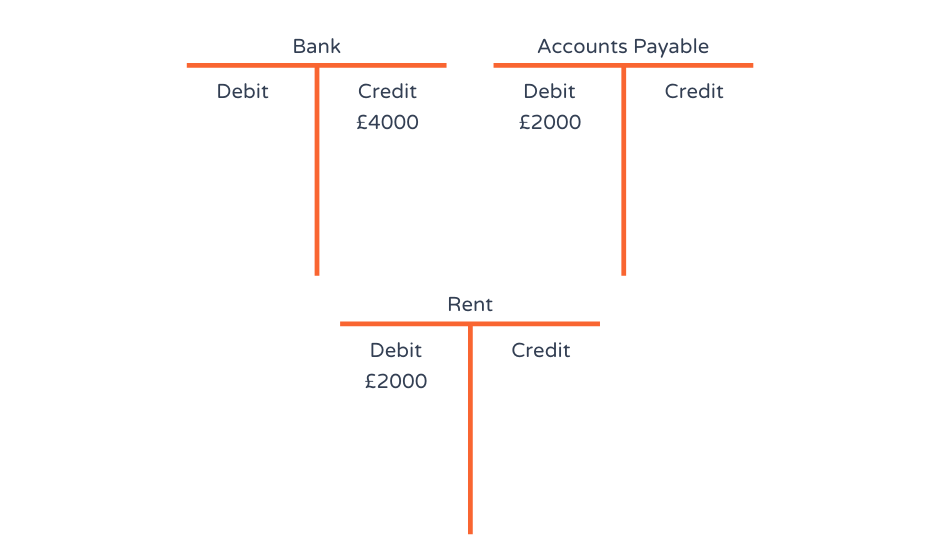

What is a T-account?
A T-account is a visual way of displaying a set of financial records that use double-entry bookkeeping. It is called a T-account because of the structural way that the report looks like T.
Any transaction a business makes will need to be recorded in the company’s general ledger. The general ledger is divided up into individual accounts which categorise similar transaction types together.
Due to the fortunate ‘T’ shape, these diagrams can be used to map out transactions before they are posted into the company’s ledgers to ensure they are correct.
Due to its simplistic nature, T-accounts are also used as a learning tool to practice transactions and double-entry accounting. T-accounts are common practice. They can be found drawn on a scrap piece of paper to templates made in accounting software.
Why do accountants use T-accounts?
T-accounts serve as a simple yet powerful tool for tracking transactions in double-entry accounting. Accountants use them because they offer:
- Clear organisation: T-accounts visually separate debits and credits, making it easier to spot errors.
- A structured audit trail: By recording every transaction in a systematic way, T-accounts help accountants and auditors trace financial movements.
- Better financial insights: When used alongside ledgers and financial statements, T-accounts help businesses track patterns in expenses and revenue.
While modern accounting software automates much of this process, understanding T-accounts is still fundamental for accountants and finance professionals.
T-Account Example Chart

A T-account has three sections. The top is the name of the account. The left-hand side is where you enter debits whilst the right-hand side is where you enter credits. Understanding the difference between credit and debit is essential for this process.
T-accounts are used to track debits and credits made to an account.
Each T-account will only display one account.
If you remember from part 1 and part 2, we went through how every debit must have a matching credit and vice versa. When one account is debited, another account will be credited.
So, to show this, T-accounts are usually displayed in pairs to show the impact of a complete business transaction in your accounts.

How are T-accounts used in accounting?
T-accounts help to visualise the process making it clear what is occurring with each transaction.
They are a useful tool for both newcomers to accounting and veteran accountants alike to quickly map out the correct way to record a transaction.
Complex entries might have impacts in multiple account. By breaking transactions down into a simple, digestible form, you can visualise which accounts are being debited and which are being credited.
This visual guide helps you ensure figures are being posted in the correct way, potentially reducing data entry errors.
T-accounts can display transactions from a specific time period such as a week or a month. By displaying multiple transactions over a time period rather than a single transaction, it allows people to see a picture of a company’s activities.

In this image, you can see a T-account which shows my bank account for the first week of March. Every day, I receive cash from my coffee sales shown in the debit column on the left. In the right column, the credits represent cash being spent either on inventory or operating costs.
Below is a simplified view of the full ledger account. When these transactions are posted to the company’s accounts, they will be displayed with more information:

You can see the specific date, the description of the transaction and a running balance beside the debits and credits.
The T-account is a quick way to work out the placement of debits/credits before it’s recorded in full detail to help avoid data entry errors. Although it may lack the detail which the ledger provides, it provides the main information, which is the amount it’s being debited/credited by.
Let’s run through several examples and put all the knowledge from the three Accounting Crunch articles to work.
Benefits of using T-accounts
T-accounts are more than just a learning tool – they play a key role in helping businesses and accountants maintain accurate financial records. Here’s why they’re valuable:
1. Simplifies transaction tracking
T-accounts break down transactions into clear debit and credit entries, making it easier to follow the movement of money.
2. Acts as a troubleshooting tool
When books don’t balance, T-accounts provide a structured way to identify where errors might have occurred.
3. Enhances financial transparency
By visually separating different accounts, T-accounts help businesses and auditors understand financial flows at a glance.
4. Reinforces double-entry accounting
Every transaction is recorded in at least two places, reducing the likelihood of missing entries.
While many businesses rely on accounting software today, understanding T-accounts remains essential for financial accuracy and decision-making.
Examples of T-Accounts
In this section, I’m going to go through different types of transactions, and I’ll be using T-accounts to display the movement of value through the business. I will use my coffee shop to represent a business throughout these examples.
You should check out my other coffee shop related articles where I breakdown the Profit and Loss Report and Balance Sheet. We also have an Accounting Glossary which you should check out if you’re unfamiliar with any of the terms used!
Example 1 – Selling a coffee
I sell a cup of coffee to a customer for £2.50. What happens in the accounts?

As you can see, my bank account (an asset account) is debited £2.50, increasing its value. My income account (revenue account) is being credited £2.50, increasing its value, making the transaction balanced.
However, I also use some inventory when making the coffee:

The ingredients for the cup of coffee are recorded as inventory (asset account). They come from my store cupboard. My inventory is reduced each time I sell a coffee so I need to credit the inventory account by 50p, reducing its value. This is a double-entry, and the accounts are balanced.
Example 2 – Purchasing a coffee machine
My coffee shop purchases another coffee machine for £700. However, I sign an agreement to pay for the machine next month. So what happens to the accounts?

As I’ve received the coffee machine, I’ve gained £700 worth of fixed assets (this account has been debited).
I’ve agreed to pay for the coffee machine next month so my accounts payable is increased (credited) by £700. Accounts payable is a liability account, keeping track of bills I still have to pay in future.
A month passes and I pay for the coffee machine.

My bank account is credited £700 (reducing its value) as I’m now paying for the coffee machine.
With the outstanding bill paid, accounts payable account is debited by £700, reducing its value and showing that I no longer owe this amount.
Example 3 – Paying rent
I need to pay £2000 for renting the unit space for my coffee shop. I pay the rent on time, on the day that it is due. So what happens to the accounts?

Rent is classed as an operating cost as it’s a standard cost required to run my business. Operating costs are a type of expense so it is debited by £2000.
To pay the rent, I’ve used cash, so my bank account (an asset account) is credited by £2000.
Next month I can’t afford to pay the rent. I agree with the landlord that I can pay it back the following month in addition to that month’s rent. So for this month:

A month passes and I pay for the rent.

As I owe both this month and last month’s rent, I have to pay £4000. My bank account is credited £4000, whilst the accounts payable account is debited £2000 and rent is debited £2000. Therefore, both debits and credits are equal in this transaction.
Example 4: Rent prepaid for a quarter
In this example, I need to pay rent for the next quarter in advance for my coffee shop’s unit space.
In January, I pay £6000 in cash to the landlord, so my bank (asset) account is credited £6000.

I now have three month’s worth of rent paid for, so my prepayments (prepaid rent) account is debited £6000.
Prepayments is an ‘asset’ account on the balance sheet. This prepaid £6000 represents an asset because my landlord owes me 3 months usage of his property since I have paid rent in advance.
Every month £2000 is credited from this account, reducing the asset as I make use of the property.

The £2000 credit each month to the Prepayment account is balanced by the £2000 debit to the rent expense account:

Phew! That last example was a complex one. It really shows how useful it is to try to draw out transactions in T-accounts before they are committed to the company records.
Common mistakes when using T-accounts
T-accounts are a great way to visualise accounting transactions, but mistakes can still happen. Here are some common pitfalls:
- Misplacing debits and credits: A simple reversal can throw off the entire balance of an account.
- Forgetting adjusting entries: Without proper adjustments, financial reports may not reflect accurate balances.
- Omitting transactions: If a transaction isn’t recorded in the T-Account, it won’t appear in the ledger or financial statements.
- Not balancing accounts: Each T-Account should eventually balance; if not, an error might exist in the double-entry system.
By double-checking entries and reconciling accounts regularly, businesses can avoid costly accounting errors.
Problems with T-accounts
While T-accounts offer many benefits, they also come with some limitations, especially in modern accounting:
1. Time-consuming for complex businesses
Manually maintaining T-accounts for every transaction can be impractical for large organisations with thousands of entries.
2. Prone to human error
If transactions are recorded incorrectly in a T-account, the mistake carries over to financial reports.
3. Limited real-world use
Businesses don’t typically use T-accounts for daily operations. Instead, ledgers and automated systems handle transaction tracking.
4. Requires double-checking
Because T-accounts rely on manual input, they need careful review to ensure accuracy.
Despite these challenges, T-accounts remain an essential learning tool and a useful way to visualise complex accounting concepts.
T-Accounting in your business
When learning the accounting process, from debits and credits to double-entry, it’s easy to get lost in the process and miss the big picture.
Whether you are an accountant or a decision-maker the language of business finance is rooted in accounting. Whatever your role is in the business, it’s worth grasping the basics of this language. Every transaction a company makes, whether it’s selling coffee, taking out a loan or purchasing an asset, has a debit and credit. This ensures a complete record of financial events is tracked and can be accurately represented by financial reports.
The key financial reports, your cash flow, profit & loss and balance sheet are an organised representation of these fundamental accounting records. They are built from the ground up by these debits and credits. It’s these reports that you’ll be analysing to aid your decision-making process.
Your profit & loss organises your revenue and expense accounts whilst your balance sheet organises your asset, liability and equity accounts. The double entry process connects these reports together. A single transaction will have impacts across all reports due to the way debits and credits work. So grasping these basics helps you delve into these reports and understand the financial story they tell.
Brixx, our financial forecasting tool, helps you with this process further. The software handles all the accounting work. When you enter any forecast activity, the double-entry process is completed for you, saving you time and giving you confidence in the numbers. It means you can spend more time analysing the results. Get started today with a free 7-day trial!
Learn more
T-Account vs Balance Sheet
A T-account is used to track specific transactions, while the balance sheet is a summary of a company’s overall financial position. Both statements are important tools in accounting and finance, and they are used to help stakeholders understand a company’s financial health.
A balance sheet is a summary of a company’s financial position at a given point in time. It provides a snapshot of the company’s financial health. The balance sheet summarizes the financial position of the company at the end of a specific period, usually at the end of the fiscal year. It is used by stakeholders to evaluate a company’s financial strength and to make investment decisions.
T-Account vs Ledger
While T-Accounts and ledgers both record financial transactions, they serve different purposes:
| Feature | T-Account | Ledger |
|---|---|---|
| Purpose | Visual representation of transactions | Official record of accounts |
| Structure | Split into debit & credit sides | Typically in a tabular format |
| Usage | Used for learning and quick analysis | Maintains a company’s financial records |
T-accounts help with understanding how transactions flow, but ledgers are the official books used in accounting reports. In practice, accountants use ledgers for final records, while T-accounts are often used for teaching and troubleshooting errors.
T-Account vs Trial Balance
T-accounts are used to track individual account balances and transactions, while trial balance summaries are used to ensure the overall accuracy of a company’s financial records.
A trial balance summary is a report that summarizes the account balances in a company’s general ledger.
It lists all the accounts and their balances, including debit and credit entries. It exists to ensure that the total debits equal the total credits, indicating that all transactions have been recorded accurately.
It is typically prepared at the end of an accounting period before financial statements are generated.
T-Account vs Journal Entry
T-accounts are used to visualize the balances of individual accounts. while a journal entry is a record of a single transaction in chronological order, showing the debits and credits of each account affected.













